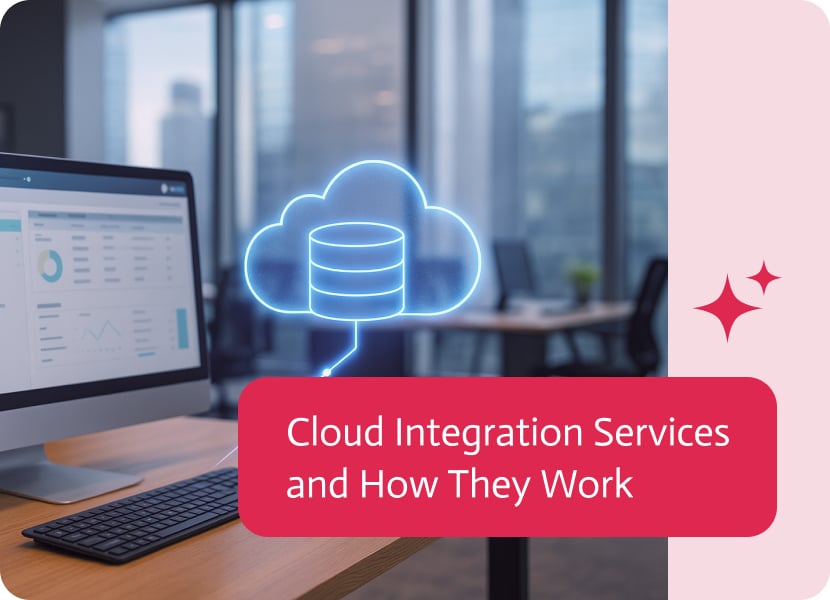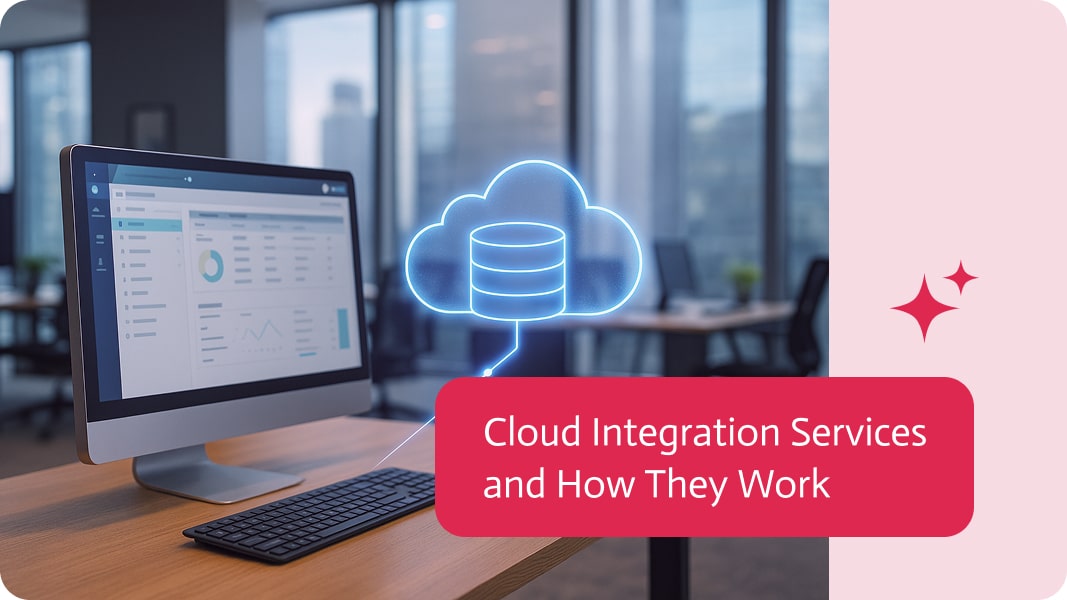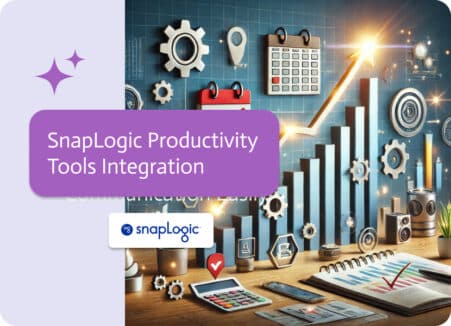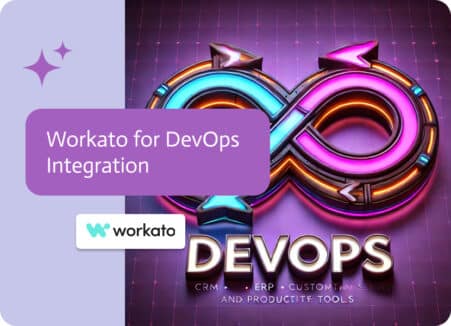

Cloud Integration Services and How They Work
Cloud integration means connecting different systems and applications while having at least one cloud based system. Using Cloud integration, your data and processes flow seamlessly between on-prem systems and cloud systems. In practice, it connects various applications, systems, repositories, and IT environments for the real-time exchange of data and information.
Often this is done through APIs and pre-built connectors: for example, linking a cloud CRM’s API to an ERP database so that sales orders automatically update financial records. In effect, cloud integration, sometimes implemented as an iPaaS, provides a centralized hub where you can map, transform, and route data between any apps or services. Users can design workflows (often via a visual interface), connect apps with adapters, apply data transformations, and monitor flows—all without building complex code for each point-to-point link. This makes it much easier to move data in real time and automate business processes across diverse systems.
Integration Platform As A Service (iPaaS): What It Is
Whether hosted on-premises or in the cloud, applications, data sources, processes, and systems can all be integrated more easily with the help of a cloud-based platform called Integration Platform as a Service, or iPaaS. In essence, it serves as a bridge that permits data exchange and communication between various systems and applications.
This is how it works: You log into a flashy web portal, almost always a drag-and-drop interface because clicking is so much fun compared to coding. Also, designing your integration flows makes it even more fun. From there, you can have a pre-built connector, map fields, set some triggers (“do this when that happens”), and even schedule things if applicable, then hit publish. Voila! Workflow is live, and guess what? The platform automates in the background.
It runs your integrations in real-time or in batch (your choice) and performs your data choreography via an API and back again all in real time, while providing a neat excitement dashboard to Let you watch, like a proud parent.
All CIaaS tools provide and offer many trustable protocols, including but not limited to: HTTP/REST, SOAP, JDBC, JMS, and your classic file transfers. There is always a visual orchestration engine where you ” if this, do that unless it’s Tuesday,” more refined options like API management workflow automation algorithms for errors, loops, and the “what on earth just happened” And surveillance analytics to monitor live what’s blown, broken, working, or about to explode.
In short? CIaaS gives you an all-in-one integration toolkit without having to manage servers. You focus on building smart connections while the cloud does the rest. Welcome to the future, no hardware required.
Challenges of Old School Integration
Old-school integration, the kind done with legacy middleware, homegrown scripts, or the Enterprise Service Bus, come with a pile of problems that most IT teams know all too well.
First off, it’s a champion at creating data silos. You know, those frustrating little islands of information that only certain departments can access, while everyone else is left waving from the mainland. Every time you want to hook up a new app or system, someone has to write a custom connection like it’s a one-off art project. Spoiler alert: that doesn’t scale.
It’s not just inconvenient—it’s costly. Traditional integration often means buying expensive servers, coughing up for hefty software licenses, and bringing in specialists who know how to coax those ancient systems into working. Want to add a new integration? Better clear your calendar. It’s going to take a while, and there’s a good chance it’ll break something along the way.
Even IBM (you know, the people who basically invented enterprise computing) admitted that these older methods were “expensive and time-consuming to create and maintain.” Ironically, the tools that were supposed to connect everything often ended up isolating data and slowing things down, kind of like trying to host a video call over a rotary phone.
In a nutshell, traditional integration lacks the agility modern businesses need. It’s slow, rigid, and about as scalable as a flip phone. Meanwhile, cloud-based integration has entered the chat, offering drag-and-drop simplicity, lower setup costs, and the ability to grow or shrink with your business. Like switching from a manual transmission to an automatic car, it’s easier, faster, and a whole lot more fun to drive.
Why iPaaS Makes Life Easier
We all know that connecting all your apps and data sources used to be a slow, expensive headache, but not anymore. iPaaS has come in and completely changed the game. Here’s how it’s making things way simpler for businesses:
It Grows with You
Whether you need to add a few shiny tools or just be able to deal with more data, iPaaS has made scaling your friend. There is no need to get fancy hardware or stress about how much you can handle anymore, you just use what you need. Whether you’re a scrappy startup or a massive company, it’s a relief to know you’re not paying for tech you’re not using.
It Moves Fast
Gone are the days when you had to wait months for custom code or massive IT projects. With iPaaS, you can build workflows using visual tools and drag-and-drop components. The need to sync marketing leads can now take days and not weeks, which means faster launches.
It Saves You Money
Instead of blowing huge amounts of cash on servers and licenses, iPaaS is more like a utility bill, what you use is what you pay for. There aren’t any surprise costs or long-term commitments, and since you’re always writing custom code or fixing connections, you save time and money on maintenance too.
It Keeps Data Clean
If your systems automatically communicate with each other, it’s far less likely that you’ll get human errors. Your CRM, ERP, and other tools stay in sync, so you’re all working from the same accurate data. You can forget about duplicates and mismatched info.
Supports Old and New Tech
You don’t have to completely scrap your old systems to try something new. iPaaS makes it easy to plug in new apps while keeping the legacy tech running. This gives you more flexibility, as well as more room to play, without having to do a full-blown overhaul.
It Lightens the Load for IT
Your team can finally stop fighting with integration problems, allowing them to focus on some real-world issues. iPaaS comes with monitoring and alerts, so when something goes wrong, it’s easier to detect and sort out. Less time spent putting out fires means more time innovating.
It Gets You to Market Sooner
iPaaS comes packed with pre-built adapters and ready-made tools for automation. This means your team can launch new services, like a mobile app and analytics platform, way faster than before. And in a cutthroat market, that kind of speed is a serious advantage.
Real-World Use Cases
Cloud integration plays a role in many practical scenarios. Here are a few common ones:
- Synchronizing ERPs and CRMs: Businesses require their systems to interface with backend systems (ERP). Getting verification guarantees that all pertinent customer information, orders, stock balances, and all other data sync smoothly.”
- Drivers of Hybrid Legacy-to-Cloud Integration: A large number of enterprises operate on outdated databases, mainframes, but they also make use of cloud based technology. iPaaS vendors serve as the connectors of these universes. A retailer will merge its site-hosted inventory relational database with a cloud-based e-store application so that online orders change instantly.”
- IoT and Sensor Integration: The IoT devices need to analyze the data that has to be generated. iPaaS directs or pushes sensor data from factory machines, vehicles, or smart meters into the cloud analytics or databases.
- Marketing and Sales Automation: Companies automate lead flow between apps. Cloud integration platforms allow these event-driven workflows, so when a marketing campaign generates a new contact, it’s instantly synced to sales systems. Likewise, customer cases in a CRM can automatically create support tickets in an ITSM tool.
- E-commerce and Supply: In retail, integrating the e-commerce website with fulfillment and ERP software could not be more important.
For instance, an order on Shopify could trigger inventory updates in NetSuite and notify shipping via a logistics API. iPaaS makes it easy to connect these cloud and on-premise pieces with prebuilt connectors.
- Data Warehousing/Analytics: Companies will pull data from a number of operational systems into a cloud data warehouse for analysis. iPaaS can automate ETL/ELT flows: e.g., nightly sync of CRM, ERP, marketing, and HR data into a data lake, more commonly known as cloud data integration or “data pipeline” integration.
This should show that iPaaS is not limited to one industry or one kind of system, it can be used wherever data needs to move. In each case, the service connects endpoints and handles the data translation or workflow logic.
Challenges Of Cloud Integration
It’s plain to see that iPaaS solves many problems, however, that’s not to say there aren’t a few challenges to keep in mind:
Security and Compliance: A Balancing Act
Sending data through cloud platforms has the potential to open a can of so-called security worms. Nearly 84% of companies admit to the difficulty of keeping security settings consistent across clouds. Encryption, key management, and identity access control don’t just happen, they need planning and constant oversight.
Latency and Performance:
When your workflows travel vast distances or on the public internet, network lags are bound to be an issue. Instant processes might stall, and large file transfers can become sluggish. You’ll need to implement smart designs, like compressing data or using dedicated agents to keep things flowing smoothly.
Hybrid Connectivity: Not as Plug-and-Play as You’d Hope
Still using on-prem systems? You’re not alone, but bridging them to the cloud securely is no small feat. Tunnels, gateways, firewalls, and VPNs need to be set up just right. You’ll also have to decide what stays on-site and what floats to the cloud, and it’s rarely obvious to spot.
Data Quality:
Automating too much without keeping monitoring your data could get messy, and quickly. With each new connection, the risk of bad data slipping through gets higher. Factors like clear ownership, validation steps, and a proper governance plan will go a long way in overall quality.
Complexity and Patterns
Integrations can turn into spaghetti real quick. Things like duplicate connections, endless job chains, or processes that hog all the resources. These so-called anti-patterns might seem like nothing at first, but trust us, they’ll come back to haunt you. So remember that discipline and good design go a long way.
Surprise Costs:
Sure, iPaaS can save money, until it doesn’t. Heavy API traffic, unexpected data transfer fees, or premium connectors can blow your budget. And if you rely on tech support often, those bills stack up.
Vendor Lock-In:
When you use one vendor’s tools, this will often mean you’re going to have to be playing by their rules. Then, should you need to move your integrations somewhere else, it’s definitely going to be harder than it looks. And remember, you’re tied to their roadmap, reliability, and pricing changes.
Not a One-Size-Fits-All Fix
iPaaS is great—but it’s not magic. Some edge cases (like ultra-low-latency trading systems or deep legacy mainframes) still need custom code and hands-on work. Sometimes, the best solution is a hybrid: off-the-shelf where you can, custom where you must.
What is Future of iPaaS?
Cloud integration is levelling up fast. Here’s a look at some of the key trends when it comes to the future of iPaaS:
Smarter AI & Learning
Cloud tools are getting smarter, they’ll now let integration platforms auto-map data fields, flag weird data, and suggest fixes with AI. Think of them as a spotter detecting issues before you even know about them.
No-Code For Everybody
Integration isn’t just for devs anymore, with no-code platforms such as Noca AI making it a cinch for non-technical teams to build complex workflows with simple drag-and-drop tools, templates, and visual designers.
Customized To You
Whether you’re in finance or manufacturing, you’ll have the option to choose pre-built connectors and workflows tuned to your needs, less setup, faster results.
Hybrid iPaaS
Integration tools are now allowing data to be synced across platforms in real time. Cross-cloud, edge-to-core communication? Standard stuff going forward.
Edge and IoT Connections
With millions of IoT (Internet of Things) devices popping up, future iPaaS platforms will link cloud workflows with edge devices, letting them process data in closer proximity to where it’s generated, cutting lag and reducing bandwidth usage.
Built-In Security and Compliance
Soon, iPaaS platforms will offer built-in encryption, smart identity controls, and auto-generated compliance reports. It will help you find sketchy dealings automatically.
Serverless and Microservices-Friendly
Serverless is fast becoming the industry norm. Integration workflows will make use of tools such as Lambda or Azure Functions for faster, scalable setups. Event-driven everything, without managing infrastructure.
DevOps and Automation Integration
CI/CD isn’t just for apps, it’s coming for integrations too. Platforms will support version control, testing, and integration-as-code. Certain ones will link with RPA tools to cover both backend and user-side tasks.
Scalability
As data continues to grow, platforms must keep up, which means no slowdowns and no crashes. We’ll have smarter auto-scaling, built-in redundancy, and real time processing to ensure a smooth service.
Final Thoughts
Businesses today are swimming in apps, platforms, and data flying around from every direction. If your systems can’t talk to each other, you’re not just losing time, you’re leaving money and insights on the table.
iPaaS makes it way easier to link your cloud apps, on-prem systems, and old-school databases without needing a small army of developers to glue it all manually. It’s not only scalable but also secure, and built to keep pace with how fast companies move today.
Bottom line? If your business is serious about being agile, data-driven, and future-ready, investing in proper cloud integration isn’t optional anymore. The companies that figure this out early will have the edge. Everyone else? They’ll be stuck duct-taping systems together while falling behind.


